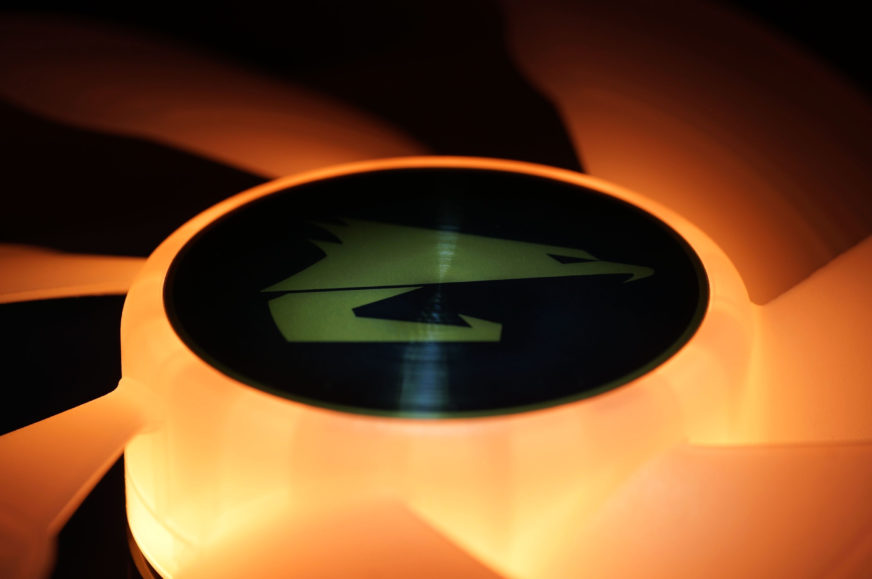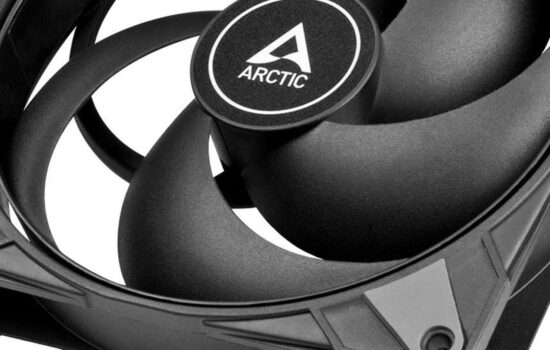Everything changes with obstacles
Blade length is always the “topic”, but will be more common with 140mm fans than smaller variants. Some bet on long blades for preference of selected features, the other manufacturer on short ones. And such (short) and overall more robust blades are also used by the 140mm Aorus fan. From certain points of view this is quite a big advantage, but for which something had to be sacrificed. It’s a quid pro quo.
Everything changes with obstacles
So far, we have described how static pressure and airflow measurements are made under conditions where the fan has no obstacles in its path. In practice, however, fans do not usually blow into an empty space, but have a filter, grille or radiator in front of or behind them, the fins of which need to be pushed through as efficiently as possible.

We will also measure both airflow and pressure through practical obstacles for the reasons stated above. These include two types of filters that are usually used in PC cases. One fine – nylon and the other plastic with a thinner mesh. One other obstacle is the hexagonal grille perforated at 50%, on which the vast majority of fans – intake and exhaust – are installed. In some cases, we measure the effect of the obstacles on the results at positions (behind or in front of the rotor) that are used in practice. All obstacles are both pushed through to detect pressure drops, but also pulled through, which in turn speaks to the impact on airflow.
We use two radiators that differ in thickness and fin density. The EK CoolStream SE120/140 is 28 mm thick and the FPI is 22, the Alphacool NexXxoS XT45 v2 is thicker (45 mm) but with less FPI. CoolStream’s fin disposition is also similar in parameters to AIOs. The results on the NexXxoS will again be attractive for those who build their own water cooling loops, where the fans should work well even at low speeds – hence the lower fin density.
These obstacles and especially the radiators, but also the grilles, increase the mechanical resistance in front of the fan, resulting in higher noise levels. However, we will still tune the fan speeds to the specified noise levels of 31 to 45 dBA. Naturally, the speeds will always be lower than when testing without obstructions, but we will maintain the noise levels for clarity. The different noise levels with and without obstacles will only be at maximum power. In this mode it will also be nice to see how the fan design works with the obstacle and in which case the noise level increases more and in which less.
- Contents
- Gigabyte Aorus 140 ARGB in detail
- Basis of the methodology, the wind tunnel
- Mounting and vibration measurement
- Initial warm-up and speed recording
- Base 6 equal noise levels…
- ... and sound color (frequency characteristic)
- Static pressure measurement…
- … and airflow
- Everything changes with obstacles
- How we measure power draw and motor power
- Measuring the intensity (and power draw) of lighting
- Results: Speed
- Results: Airlow w/o obstacles
- Results: Airflow through a nylon filter
- Results: Airflow through a plastic filter
- Results: Airflow through a hexagonal grille
- Results: Airflow through a thinner radiator
- Results: Airflow through a thicker radiator
- Results: Static pressure w/o obstacles
- Results: Static pressure through a nylon filter
- Results: Static pressure through a plastic filter
- Results: Static pressure through a hexagonal grille
- Results: Static pressure through a thinner radiator
- Results: Static pressure through a thicker radiator
- Results: Static pressure, efficiency by orientation
- Reality vs. specifications
- Results: Frequency response of sound w/o obstacles
- Results: Frequency response of sound with a dust filter
- Results: Frequency response of sound with a hexagonal grille
- Results: Frequency response of sound with a radiator
- Results: Vibration, in total (3D vector length)
- Results: Vibration, X-axis
- Results: Vibration, Y-axis
- Results: Vibration, Z-axis
- Results: Power draw (and motor power)
- Results: Cooling performance per watt, airflow
- Results: Cooling performance per watt, static pressure
- Airflow per euro
- Static pressure per euro
- Results: Lighting – LED luminance and power draw
- Results: LED to motor power draw ratio
- Evaluation













Nice to see the 140mm fan reviews rolling!
Also, would it be possible to publish noise samples for your fan/cooler reviews? Preferably for all scenarios where you perform frequency analysis?
And they will continue to come, tests of 140 mm fans. But we probably won’t exaggerate it, so that they stay in a relevant ratio (according to the interest in whichever format in general) to 120 mm models.
Which noise samples do you mean? From spectrographs? Do you want that data for your own purposes, for your own analysis? If so, we can send you the noise levels at all frequencies in all tested scenarios almost immediately (e.g. by e-mail). We can certainly post them on the web somewhere, but it will take more time, as we will need to create a section for this somewhere. Making it make sense on the web will be more time-consuming and at the moment we are quite overloaded and it is hard to find space for extra activities. :/
Always looking forward to your fan reviews regardless of size!
For noise samples, I mean audio files so I can listen to them to make a subjective judgement. In reviews you often mention the differences in frequencies between obstacles/fan models etc. With audio files to listen to, it will be much more easy to understand the difference.
Maybe you can consider compiling the audio files for each fan and upload to YouTube as a video, for example, which perhaps take relatively little effort, though I am not sure if the audio quality is satisfactory. Anyway, it is only a suggestion so please decide on whether you think it is worth the effort or not.
I understand now, and I am also sorry that I am now likely to disappoint you.
Sound recordings are something I boycott against and the goal is to get more and more people to learn to read spectrograms. Sure, it’s more complicated, but we plan to publish materials to facilitate reading these charts. We will select a few fans that have the biggest differences in the frequency characteristic of the sound, make a sound recording of them, and put a spectrogram against it. On it we then explain which component of the sound represents what in the spectral analysis.
You know, I’m willing to sacrifice all my time for these things, but I have to see some meaning behind the results. And sound recordings don’t make sense to me because they can be extremely misleading. While the user thinks he’s hearing the fan, the sound system with the speaker on top is laughing at how they have been perfectly fooled. It is certainly not necessary to elaborate that the same recording sounds different on each speaker (it is determined by the frequency characteristics of the sound equipment of the end user), and this also with regard to the volume that the person sets. To judge something on the basis of the sound recording is therefore very inaccurate and misleading. I would probably suffer a lot when making them with my high demands on the relevance of things and at the same time it would reduce the relevance of spectrogram, which everyone sees the same way.
I believe that after this message you will not give up on our tests and sooner or later you will surely find out (also with the help of various auxiliary materials, which we plan to publish on this topic), that you understand everything perfectly also with the help of spectrograms. 🙂
Not disappointed at all, very satisfied with your answer. Looking forward to the articles explaining spectrograms, I’ll admit I never really understood how to interpret them.